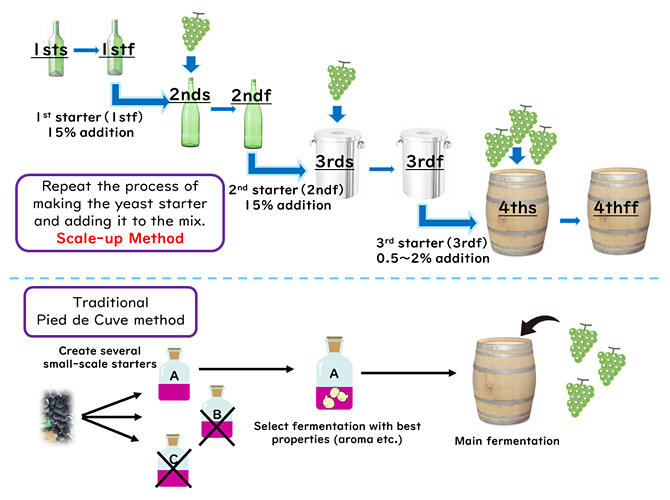A research group led by Associate Professor Misa Otoguro and Associate Professor Munekazu Kishimoto of the Institute of Enology and Viticulture, University of Yamanashi, and Marufuji Winery (Koshu City, Yamanashi Prefecture) has successfully developed a practical scale-up method to brew high-quality wine through spontaneous fermentation, without using cultured yeast imported from France and other countries that most wineries currently use.
As with the concept of vintage wine, climatic conditions and grape growth vary from year to year, and the natural yeasts that adhere to the grapes are also not constant. As such, production of a stable and healthy fermentation process every year is very difficult. The research group conducted a detailed study on the microorganisms responsible for fermentation and the aroma components of wine with a scale-up method using natural yeast that was originally developed with the aim of producing high-quality, flavorful wine and fewer unpleasant aromas such as acetic acid and ethyl acetate even from natural fermentation.

Provided by the University of Yamanashi
In the scale-up method, about one kilogram of grapes are harvested 10 days before fermentation takes place and natural fermentation is started on a small scale (stage 1). After that, the scale of fermentation is gradually increased, and the addition rate of the third stage fermented liquor, which will eventually become the starter, is reduced to 0.5-2% and added to the final stage grape juice for fermentation. In the early stages of fermentation, a small number of yeasts other than Saccharomyces cerevisiae grow and produce a small amount of alcohol. When new grape juice is added and fermentation continues, the growth of alcohol-sensitive yeast is weakened, but Saccharomyces cerevisiae, which is highly resistant to alcohol, gradually proliferates and eventually takes the lead role in fermentation, resulting in a healthy fermentation.
In order to standardise this method, the researchers used Muscat Bailey A grapes grown and harvested at the University of Yamanashi's farm to understand the effectiveness of the scale-up method in a five-year brewing trial. They were able to encourage the growth of yeasts other than Saccharomyces cerevisiae, which are present in very small amounts in grapes, by encouraging them to adapt to the fermentation environment and by limiting the amount of fermented liquid added at the final stage to about 0.5% to 2%. This makes it possible to impart the aromatic complexity characteristic of naturally fermented wines, and the researchers hope it will be applied to organic wines that aim for higher quality.
"Moving forward, we would like to identify the characteristics of microorganisms that bring complexity to the aroma and flavor of wine made by natural fermentation and combine this with a scale-up method using natural yeast from organically grown grapes to develop applications for the ultimate organic wine," explained Otoguro. "We would also like to contribute to Japanese winemaking that expresses regional characteristics (terroir) in various wine regions in Japan."
This article has been translated by JST with permission from The Science News Ltd. (https://sci-news.co.jp/). Unauthorized reproduction of the article and photographs is prohibited.




